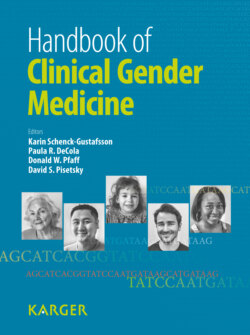Читать книгу Handbook of Clinical Gender Medicine - Группа авторов - Страница 27
На сайте Литреса книга снята с продажи.
Initial Signal in China
ОглавлениеA regular and quite predictable relationship between total numbers of male and female births is a fixed, biological characteristic of human populations. The discovery of the consistency, across time and space, of the sex ratio at birth (SRB) for human beings is one of the very earliest findings of the modern discipline of demography. Medical and demographic research subsequently identified some differences in SRB that correspond with ethnicity, birth order, parental age, and other factors [1–3], but such differences were always quite small; until the 1980s, the SRB for large human populations tended to fall within a narrow range, usually around 103-106 newborn boys for every 100 newborn girls and centering not above 105. Until the 1980s, exceptions to this generality were mainly registered in small populations and attributable to chance.
Table 1. The ever-increasing gender imbalance in China. Reported SRBs and sex ratios of the population age 0-4 years: 1953-2005 (boys per 100 girls)
| Year of census or survey | Sex ratio of births | Sex ratio of the population age 0-4 |
| 1953 | – | 107.0 |
| 1964 | – | 105.7 |
| 1982 | 108.5 | 107.1 |
| 1990 | 111.4 | 110.2 |
| 1995 | 115.6 | 118.4 |
| 1999 | 117.0 | 119.5 |
| 2005 | 118.9 | 122.7 |
| Sources [46; Chinese Academy of Social Science, unpubl. data]. Reprinted with permission. |
The modern phenomenon of biologically unnatural increases in the SRB was first noticed in the 1980s - in China, the world’s most populous country. In 1979, China promulgated its forcible antinatalist ‘One Child Policy’ [4]. This program continues to be enforced to this day, albeit with regional and temporal variations in severity [5]. In 1982, China’s national population census - the first to be conducted in nearly two decades - reported an SRB of 108.5, a striking and disturbing demographic anomaly. Initially, researchers surmised that this abnormal imbalance might be in large part statistical artifact, under the hypothesis that Chinese parents might be disposed to conceal the birth of a daughter so as to have another chance for a son, given the birth quotas associated with the ‘One Child Policy’.1 However, successive Chinese population censuses registered ever-higher SRBs. By the 2005 ‘mini-census’ (1% intercensal survey), China’s SRB approached 120 - and the reported nationwide sex ratio for children under 5 was even higher (table 1).2 Over the last two decades some discrepancies and inconsistencies among Chinese data sources - census numbers, vital registration reports, hospital delivery records, and school enrollment figures - have been identified with regard to SRBs and child sex ratios [8]. However, there is absolutely no doubt that distorted sex ratios for newborns and children prevail in China today - and that these gender imbalances have increased dramatically during the decades of the ‘One Child Policy’.
Chinese census data outline the basic geo-demography of China’s imbalanced SRBs. For the country as a whole, SRBs since 1982 have consistently been lowest for China’s cities and highest for rural areas. In China’s 2005 ‘mini-census’, reported SRBs were roughly 123 for rural areas, 120 for towns, and 115 for cities [6]. However, there are major SRB variations within China at the regional level; as of 2005, only three provinces reported essentially ‘normal’ SRBs, while many more reported SRBs of 125 or more. Two provinces reported levels in excess of 130 (fig. 1). The geography of China’s gender imbalance is further highlighted by a county-level breakout of sex ratios for young children in the year 2000 (fig. 2). As may be seen, sex ratios are essentially ‘normal’ (105 or lower) in much of Western China and along parts of the country’s northern border - areas where non-Han ethnic minorities predominate. Higher-than-normal gender imbalances are seen in China’s east and south populated primarily of the Han majority. There are tremendous variations in the extremity of the condition within this Han expanse: a number of inland and coastal areas stand out as epicenters of the problem and are marked by concentrations of counties, each encompassing millions or tens of millions of people, wherein child sex ratios of 150 or greater prevail. Demographers Guilmoto and Oliveau [10] describe these radical-imbalance areas as ‘hot spots’. This phenomenon has diffused across China’s population over the past three decades and figure 2 may be regarded as the map of a rising national epidemic.
